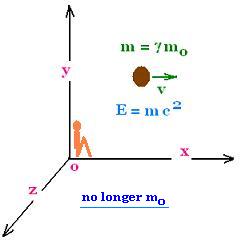Contents
Special Relativity
© The scientific sentence. 2010
| Mass-Energy Equivalence

Let's consider a particle of mass m0 measured
in the two inertial frames at rest oxyz and o'x'y'z'.
If the mass m0 is fixed in the frame o'x'y'z' now
moving at the speed u relative to the frame oxyz, the mass of
the particle is still m0 in o'x'y'z', but becomes
m = γ m0 for the observer at rest oxyz.
In the frame oxyz at rest:
If a force F (doing a work, then changing the kinetic energy),
is applied on the particle, along the x-axis, we can write:
KE = ∫ F dx
F = dP/dt
P = mu = γm0u
(P is the linear momentum of the particle, and u is the
speed of the particle measured in oxyz. (m0 ix
fixed in o'x'y'z')
Hence:
F = d(mu)/dt = mdu/dt + udm/dt, so
KE = ∫ Fdx = ∫ (mdudx/dt + udmdx/dt)
as u = dx/dt, thus:
KE = ∫ (mudu + u2dm) = ∫ ( mdu/dm + u)udm
But,
du/dm = 1/(dm/du) , then:
dm/du = m0d[γ]/du
d[γ]/du = - d/du([ 1 - u2/c2]1/2)/[ 1 - u2/c2]
d/du([ 1 - u2/c2]1/2) = (1/2)[ 1 - u2/c2] - 1/2 ( - 2u/c2) = [1 - u2/c2] - 1/2 ( - u/c2)
Therefore:
d[γ]/du = (u/c2) /[ 1 - u2/c2]3/2
dm/du = m0d[γ]/du = (m/γ)d[γ]/du = m (u/c2) /[ 1 - u2/c2] = mu /[ c2 - u2]
dm/du = mu /[ c2 - u2]
Then:
mdu/dm = [ c2 - u2]/u
It follows that:
KE = ∫ ( mdu/dm + u)udm = ∫ ([ c2 - u2]dm + u2dm) = ∫ c2dm
The mass varies from m0 to m,
KE = ∫ c2dm = c2∫ dm = c2[m](m0 → m)
KE = c2[m - m0]
We do not have potentia;l energy here, we can just write:
KE + m0c2 = mc2
and call the term m0c2 energy at rest and
E the total energy.
and then : E = E0 + KE
With:
E = mc2
The total energy of a particle of mass at rest m0,
moving at velocity u is:
E = mc2
with m = m0/[1 - u2/c2]1/2.
|
|